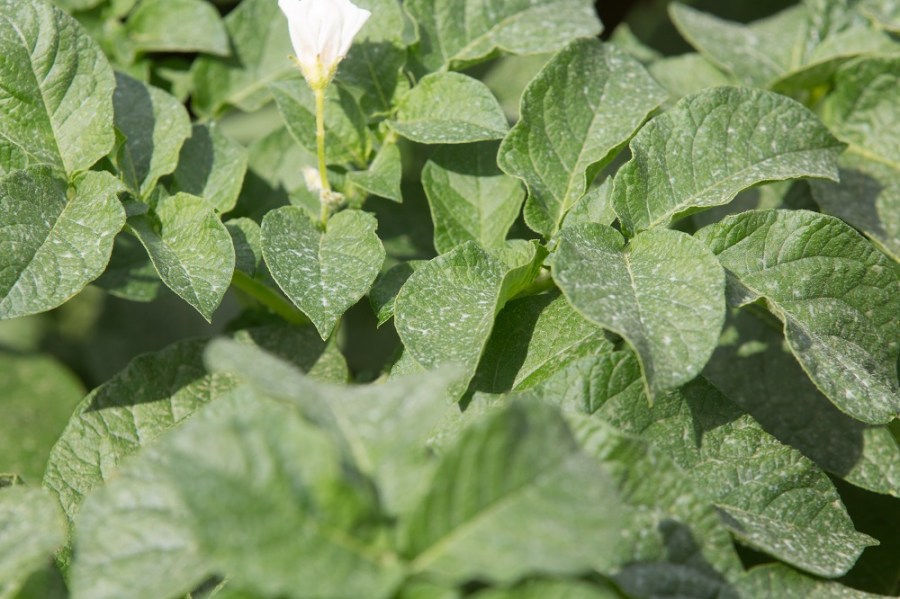Can a fertiliser be a fungicide’s best friend? CPM gets the gen on a nutritional product which appears to bring benefits to the blight programme.
It makes sense to use with blight fungicides to enhance the control of the disease.
By Lucy de la Pasture
It’s a question many growers and agronomists have been asking for a long time – do some nutrient products bring something to the party when it comes to disease control?
The role plant nutrients play in plant health has often had the waters muddied by pseudo-science. Products claiming to increase yield have been knocking around for years, many supported by a lot of gloss but not much substance, points out Omex technical development manager, David Booty.
That’s why Omex have put together a portfolio of replicated trials on a whole range of different crops for their nutrient product Zynergy, a combination of copper, zinc and organic acids. The results seem to back up what the product name implies, that there’s a synergistic effect when it comes to disease control.
One of the crops where extensive trials work has been conducted is potatoes and Norfolk independent agronomist, John Purslow, believes that Zynergy has had a positive effect on the crops he’s used it on.
So what’s he basing his opinion on? The role of copper and zinc in plants and a mind that’s able to join the dots when it comes to rationalising their field effects.
“It makes sense to use in conjunction with blight fungicides to enhance the control of the disease. I’m also using P2O5 (phosphite) on potatoes and believe it’s useful to combine the two to benefit from the secondary effects of both biostimulant and micronutrient on blight,” he says.
Both copper and zinc play a part in the metabolism of plants. One of the roles of both nutrients is to support the crop’s immune systems, explains David Booty.
“Part of zinc’s function is in maintaining the integumentary system of the plant, which affects skin elasticity, wound healing and disease suppression. Copper forms part of the phenolic compounds used by plants to suppress infection,” he explains.
The formulation of Zynergy seems to enhance the bioavailability of the micronutrients, according to statistically significant trials carried out at Sutton Bonnington, University of Nottinghamshire.
“Prof Steve Rossall at Sutton Bonnington looked at the effects and simulated rainfastness of Zynergy compared with tank-mixed zinc and copper. Trials were inoculated using a virulent strain of blight and in both cases the formulated product outperformed the mix of straight products, copper sulphate and zinc oxide,” he explains.

Omex trials carried out by Nottingham University.
Both agronomist and manufacturer are quick to point out that it’s not fungicidal properties of the micronutrients that appears to be reducing the size of blight lesions in these trials but the effect they have on the plant to withstand disease attacks.
Further trials work was carried out by Eurofins in 2016, on a site in Derbys on the blight-susceptible variety, Maris Piper.
“There was an economic response when Zynergy was applied with fluazinam and a foliar feed., producing a difference in marketable yield of 15% over a full fungicide programme. In 2016 the trial again showed a yield increase where Zynergy was applied with a Revus (mandipropamid)/Ranman (cyazofamid) programme, applied on a seven-day interval.”
In this trial the cost of the treatment, at £4.50/ha on a 10-spray programme, produced an additional 7t of potatoes, he points out.

Source: Omex trials by Eurofins 2016
John Purslow has also used Zynergy in wheat and this season he’s opted for an application at T0 instead of a fungicide.
“A lot of my land is short of zinc and disease-resistant varieties, like KWS Siskin, might not need a fungicide but an application of micronutrients at this timing will boost the plant’s immune system and make it more resilient,” he reasons.
The possibilities for use in the wheat fungicide programme are something Omex are investigating in further trials, adds David Booty.
“So far we’ve found that in a low fungicide-input scenario, the addition of Zynergy has a statistically significant impact on disease levels when applied at T1 and T2,” he says, referring to trial site results from Wilts on JB Diego.
“Positioning Zynergy earlier, at T0 and T1, may help keep disease levels low early in the programme so could have a role in strengthening fungicide programmes where an SDHI isn’t used, but more trials work is needed,” he comments.




